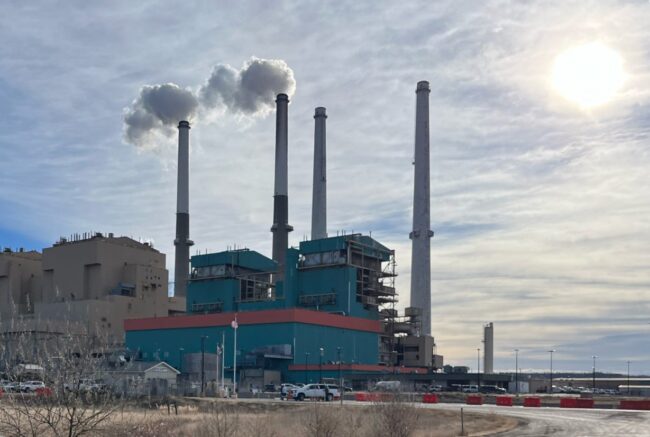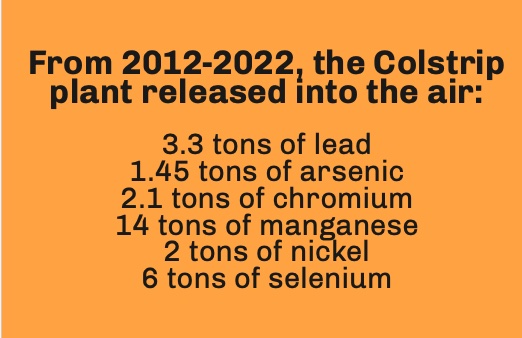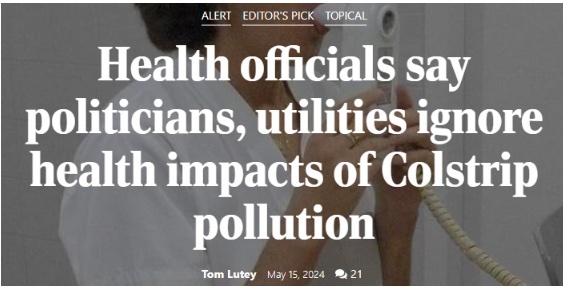By Anne Hedges

The Colstrip plant in eastern Montana is the nation’s number one bad actor for toxic air pollution. Colstrip Unit 4 has the highest emission rate of toxic pollutants of any coal-burning unit in the nation. Its emissions rate is 50% higher than the next closest coal unit. Colstrip Unit 3 is not far behind, having the third highest toxic air emissions rate in the nation.
The Colstrip plant is one of a handful of plants that has not installed modern pollution control technology to limit its toxic emissions. In fact, there are 170 coal-burning units in the country that use the same technology as Colstrip, but it is the only one that hasn’t installed industry-standard control technology to reduce emissions of lead, arsenic, chromium, and more.
As a result, the Colstrip plant’s toxic emissions are staggeringly high.
Colstrip Units 3 and 4 were shut down for most of the summer of 2018 because the plant couldn’t meet the air pollution requirements for toxins. Now, the U.S. Environmental Protection Agency (EPA) has updated those air pollution requirements for coal-fired power plants, and the Colstrip plant should not be made an exception.

EPA’s New Toxic Pollution Rule for Power Plants
On April 24, 2024, the EPA took a long overdue step to limit mercury and air toxics from coal-fired power plants. The updated Mercury and Air Toxics Standards (MATS) will limit air emissions of mercury from facilities that burn lignite coal and toxic air pollutants such as lead, arsenic, nickel, and more. While the new mercury standard will not impact Montana power plants because they burn subbituminous coal, the rule will require significant updates at the outdated Colstrip plant because it has the highest emission rate of toxic air pollutants of any coal plant in the nation.
The new MATS rule is a long time coming. Owners of coal-fired power plants have spent decades fighting EPA’s efforts to limit toxic air pollution from burning coal. They’ve argued that decreasing pollution is unnecessary and expensive – standard tropes of an industry that is more concerned about corporate profits than people’s health. Polluters and their allies are also arguing that EPA is not giving plant owners enough time to comply with the updated standard, but this argument should fall flat.
Congress directed EPA to limit harmful pollutants from industrial operations in the 1990 Clean Air Act Amendments (CAAA). Despite being the largest mercury polluters in the nation, power plant owners were able to stall the adoption of any limits on toxic emissions from coal-burning plants until 2012 when Pres. Barack Obama’s EPA found that it was “appropriate and necessary” to limit these harmful emissions. The 1990 CAAA required EPA to establish limits on hazardous air pollutants for each class of industrial operations based upon the maximum level of emissions reductions that were being achieved by similar facilities. These standards were then required to be updated every eight years to ensure that public health would benefit as technology improved. If so, EPA had to revise the standard to require all sources to limit their emissions to a level that the best operators were already achieving. Once EPA revised a standard, Congress required EPA to require all sources meet that standard within three years. This same three-year timeframe for compliance with a new toxic air pollution standard applies to refineries, chemical plants, cement kilns, and every other type of industrial source that pumps high levels of toxins into the air each year. Coal-fired power plants are no exception; they have just managed to stall such regulation longer than other industrial operations.
Power plant owners have challenged the rule at every step, from when it was first introduced to the most recent update of the rule. Interestingly, nearly every power plant in the nation is already limiting pollution to a level that is lower than the one recently set by EPA. Despite this, the owners of the most polluting plants – like the Colstrip plant – are continuing to argue that it is not fair that they should have to limit pollution to levels already achieved by the vast majority of plants.
The Trump Administration tried and failed to revoke the Obama era decision that it was appropriate and necessary to limit toxic air pollution from power plants. In 2023, the Biden Administration, in compliance with the 1990 CAAA, finally proposed emission limits that were based on what the best performing power plants in the nation were achieving for limiting toxic pollution. EPA finalized its proposal in April, making some changes to its final rule based upon comments from industrial polluters.

Now, some states, including Montana, are challenging the rule, once again arguing that it is unnecessary and too expensive to protect public health from mercury, arsenic, lead, and other acutely toxic substances. Considering the cost a family must pay for treatment for the most common cancers associated with high arsenic levels (skin, bladder, and lung cancer), requiring plants to limit their pollution to the same level that most other plants are already achieving is imminently reasonable. The law is clearly achievable, and so states are not arguing that EPA set the standard improperly. Instead, they are arguing that MATS will create hardship for some utilities. The owners of Colstrip are griping that the new standard will cost too much. For a plant that appears to pays more than $200 million each year for fuel, it’s unconscionable that the owners aren’t willing to invest in public health protections. The real question is: how many people will courts allow to get sick in order to protect a few bad actors who don’t want to limit their toxic emissions?
Montanans and nearby Tribes deserve clean air just as much as other places in the nation. We also deserve continuous emissions monitors that will guarantee lower levels of toxic pollution are released from the plant on a continuous basis, not just once a quarter as the plant currently measures compliance.
Our Congressional delegation needs to hear that you support public health and clean air. Send a message to our Senators and Representatives and sign a petition online here: https://tinyurl.com/MontanaMATS.
This article was published in the July 2024 issue of Down To Earth.

